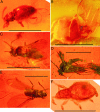Amber from western Amazonia reveals Neotropical diversity during the middle Miocene
- PMID: 16950875
- PMCID: PMC1564219
- DOI: 10.1073/pnas.0605801103
Amber from western Amazonia reveals Neotropical diversity during the middle Miocene
Abstract
Tertiary insects and arachnids have been virtually unknown from the vast western Amazonian basin. We report here the discovery of amber from this region containing a diverse fossil arthropod fauna (13 hexapod families and 3 arachnid species) and abundant microfossil inclusions (pollen, spores, algae, and cyanophyceae). This unique fossil assemblage, recovered from middle Miocene deposits of northeastern Peru, greatly increases the known diversity of Cenozoic tropical-equatorial arthropods and microorganisms and provides insights into the biogeography and evolutionary history of modern Neotropical biota. It also strengthens evidence for the presence of more modern, high-diversity tropical rainforest ecosystems during the middle Miocene in western Amazonia.
Conflict of interest statement
Conflict of interest statement: No conflicts declared.
Figures




References
-
- De Franceschi D, Dejax J, De Ploëg G. C R Acad Sci. 2000;330:227–233.
-
- Poinar GO., Jr . Life in Amber. Stanford, CA: Stanford Univ Press; 1992.
-
- Anderson KB, Crelling JC, editors. Amber, Resinite, and Fossil Resins. Vol 617. Washington, DC: Am Chemists Soc; 1995. pp. 11–17. American Chemists Society Symposia Series.
-
- Martínez-Delclòs X, Briggs DEG, Peñalver E. Palaeogeogr Palaeoclimatol Palaeoecol. 2004;203:19–64.
-
- Ensaf A, Nel A, Garrouste R. Mitt Schweiz Entomol Gesell. 2003;76:245–248.
Publication types
MeSH terms
Substances
LinkOut - more resources
Full Text Sources

